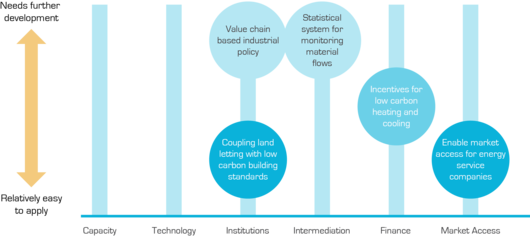How Sustainable Entrepreneurship Can Drive Low-Carbon DevelopmentThe Business Challenge of Low Carbon DevelopmentEconomic growth in China has followed a resource-intensive path similar to that taken by many of the world’s developed countries. This is of particular concern due to the impact of China on global markets for energy and resources as well as the negative environmental and social impacts generated by business-as-usual approaches. Low-carbon, energy and resource efficient business strategies are expected to play an important part in levering a paradigm shift. What are the necessary conditions to enable entrepreneurial action to achieve this aim? What types of business models are successful and what are the roles for different groups of actors, such as policy makers, academia, and civil society?
Addressing Leverage Points with Examples of Good Practice These are the questions the CSCP is working to address in its new international study of good practice entitled How Entrepreneurship Can Drive Low-Carbon Development that is being produced as part of the Low Carbon Future Cities (LCFC) project. The project is a collaboration initiative of the cities of Düsseldorf, Germany, and Wuxi, China, with funding from Stiftung Mercator. Two main themes emerged for how entrepreneurship can drive low carbon development: the need for multi-stakeholder cooperation at the local level and for systemic thinking beyond isolated impacts and company and organisational boundaries.
This study builds upon the outcomes of the previous report entitled “Leverage Points for Low Carbon Entrepreneurship in Wuxi”. While that report analysed the leverage points and low carbon markets that form the entrepreneurial landscape of Wuxi, the current report concentrates on the identification, description and evaluation of good practice and illustrates how local framework conditions enable successful low-carbon entrepreneurship and how entrepreneurs can operate within them. The report provides an initial overview of the major economic, environmental, and social potential of innovative low carbon business strategies and models and the interconnections with surrounding socio-economic systems.
Entrepreneurial Opportunities: Learning from 20 Successful Business Models In addition to an analysis of policy frameworks and market-based instruments to stimulate entrepreneurship, the inclusion of 20 innovative international case studies identifies examples for where, how and why business can successfully drive low carbon development and deliver added value. The diverse set of examples ranges from product innovation and international cooperation to financing solutions and initiatives led by local municipalities. Transferability criteria and key learnings for each case are also presented to maximise learning for Wuxi and other cities with aspirations for low carbon development.  Identifying and engaging a wide range of actors to make it happen Sustainable entrepreneurship should be a pillar of a future low carbon economy. However, companies – in particular small and medium-sized enterprises (SMEs) – have limited time, skills, and resources to identify and develop low carbon business solutions. This makes SMEs highly vulnerable to systemic barriers. From the perspective of low carbon development, their innovative capacity is at stake.
Therefore, the approach taken by the CSCP targets a wider audience of enablers that shape the landscape for entrepreneurship in cities and that have potential to directly support SMEs. This includes business and industry associations, large enterprises, private consultancies and financial institutions as well as government actors.
Both the approach and good practices cases that are presented were tested during a workshop with policymakers, business and academic representatives during the 2nd LCFC Stakeholder Forum in Wuxi, China. Workshop participants provided positive feedback and helped generate a number of new ideas for collaborative action. The final report contains recommendations for each these groups in terms of concrete actions and specific measures (see example below) to support their role in shaping an environment that makes low carbon business a rewarding option for entrepreneurs and society alike. Further informationReport: Leverage Points for Low Carbon Entrepreneurship in Wuxi
For more information please contact
|
||

